Essential checks for a Motorcycle before buying..
Buying a used motorcycle can be an exciting venture, but it’s important to conduct thorough checks to ensure you’re making a wise investment. Here are the key steps to take before sealing the deal:
1. Visual Inspection
Start with a comprehensive visual inspection of the motorcycle. Look for any signs of damage, rust, or wear that could indicate past accidents or neglect. Check the frame for cracks, the wheels for dents, and the tires for tread life and uneven wear.
2. Mechanical Health
Examine the engine for leaks, listen for unusual noises, and check the oil level and quality. Ensure that the brakes, clutch, and gearbox function smoothly. It’s also a good idea to inspect the chain or belt for proper tension and condition.
3. Electrical Systems
Test all the lights, indicators, and the horn. Make sure the battery is in good condition and that all electrical connections are secure and corrosion-free.
4. Suspension and Steering
Push down on the suspension to check for smooth operation and rebound. Inspect the fork seals for leaks. The handlebars should turn freely from lock to lock without resistance or strange noises.
5. Test Ride
If possible, take the motorcycle for a test ride. Pay attention to how the bike handles, accelerates, brakes, and shifts. Any issues during the ride could be a red flag.
6. Service History
Review the motorcycle’s service history to ensure it has been maintained regularly. Look for records of oil changes, brake service, and other routine maintenance.
7. Ownership Documents
Verify the motorcycle’s ownership documents, including the title and registration. Ensure the Vehicle Identification Number (VIN) matches the documents.
8. History Check
Perform a history check using a reputable service like hpi.co.uk or checkamotor.co.uk. This will reveal if the motorcycle has any outstanding finance, has been stolen, or has been involved in any serious accidents leading to insurance write-offs.
9. MOT and Mileage Verification
Ensure the motorcycle has a valid MOT certificate and check the mileage against the service history to look for any discrepancies.
10. Final Assessment
After completing all the checks, assess the motorcycle’s overall condition and consider whether it meets your expectations and budget. Don’t hesitate to walk away if there are too many concerns.
Remember, taking the time to perform these checks can save you from future headaches and unexpected expenses. It’s also advisable to bring along a knowledgeable friend or a professional mechanic if you’re not confident in assessing the motorcycle’s condition yourself. Safe riding and happy buying!
(1) Motorcycle History Check | Motorcycle Check | RAC. https://www.rac.co.uk/buying-a-car/rac-car-data-check/motorbike.
(2) How to Buy a Used Motorbike – Full Checklist – Motorscan. https://motorscan.co.uk/guides/buying-a-used-motorbike-how-to-buy-a-used-motorbike-full-checklist.
(3) 7 Things to Inspect Before Buying a Used Motorcycle. https://bing.com/search?q=motorcycle+pre-purchase+checks.
(4) 7 Things to Inspect Before Buying a Used Motorcycle. https://www.cycletrader.com/blog/2023/03/22/7-things-to-inspect-before-buying-a-used-motorcycle/.
(5) Buying a Used Motorcycle — Inspection Checklist PDF – Motofomo. https://motofomo.com/buying-a-used-motorcycle-inspection-checklist/.
(6) Motorcycle Servicing – Pre-ride Checks – motorcycle parts warehouse. https://motorcyclepartswarehouse.co.uk/blog/post/motorcycle-servicing-pre-ride-checks/.
Car insurance write-off categories explained..

When a vehicle is involved in an accident or sustains significant damage, insurance companies categorise it based on the level of damage and its potential for repair. The write-off categories help determine the financial settlement and future status of the vehicle. The UK has four main write-off categories: Category A, Category B, Category S, and Category N.
- Category A: Category A is the most severe write-off category and applies to vehicles that are considered completely beyond repair and unsafe to be returned to the road. These vehicles are typically extensively damaged, with no salvageable parts. Category A write-offs must be scrapped, and the DVLA (Driver and Vehicle Licensing Agency) is informed.
- Category B: Category B write-offs also denote vehicles that are beyond repair, but they may have salvageable parts. Although these vehicles cannot be returned to the road, their components can be safely recycled or reused. Like Category A, Category B write-offs must be scrapped and reported to the DVLA.
- Category S (formerly Category C): Category S denotes a vehicle that has sustained structural damage but can be repaired. These vehicles have been assessed as uneconomical to repair by the insurer, considering the cost of repair relative to the vehicle’s value. Once repaired, a Category S vehicle can be returned to the road, but it must pass a thorough inspection by a qualified professional.
- Category N (formerly Category D): Category N represents vehicles with non-structural damage, typically involving electrical or cosmetic issues. Like Category S, these vehicles are considered repairable and can be returned to the road once repaired and inspected by a professional.
Important Considerations
- When a vehicle is written off, the insurer will typically offer a settlement based on its pre-accident value and the category it falls under.
- Category S and Category N vehicles may require additional inspections and documentation before they can be legally driven on the road.
- It’s crucial for buyers to be aware of a vehicle’s write-off category when purchasing a second-hand car. This information can be obtained from the seller or through a vehicle history check.
To conclude the UK car insurance write-off categories provide a standardized system for classifying damaged vehicles and determining their future status. While Category A and B write-offs are beyond repair and must be scrapped, Category S and N vehicles can be repaired and returned to the road after meeting certain criteria. It’s essential for insurance policyholders, buyers, and sellers to understand these categories to ensure informed decision-making regarding damaged vehicles.
The new 2023 XMAX 300


When you see what the XMAX 300 has to offer it’s no surprise that this stylish Sport Scooter is one of the best-selling models in the class. Featuring a dynamic new body design and smartphone connectivity, the new high specification XMAX 300 is equipped to make every journey a very special experience.
With the new XMAX 300 you’re able to stay in touch with friends, family and work. Just download Yamaha’s free MyRide app, link your smartphone to the scooter via Bluetooth® and you can view incoming calls and messages on the new 4.3-inch LCD instruments. And the MyRide app also gives you access to a wide variety of machine running information and riding data.
The dynamic angular body design with its new X-shaped front lighting gives the new XMAX 300 an even more radical and distinctive look – and new shape 3D boomerang side covers reinforce the pure MAX DNA. High-mounted LED front flashers make you visible in dense traffic – and a new seat improves comfort in stop/start urban riding.
At a glance
4.3-inch LCD instruments
Smartphone connectivity
Dynamic body design
Radical X-shaped headlight
New shape seat with easy access
High-mounted front flashers
Full LED lighting
EURO5 Blue Core 300cc engine
Storage for 2 full-face helmets
Traction control system (TCS)
Smart Key keyless ignition
Adjustable screen and handlebars
Honda PCX 125 (2021) – What’s new?
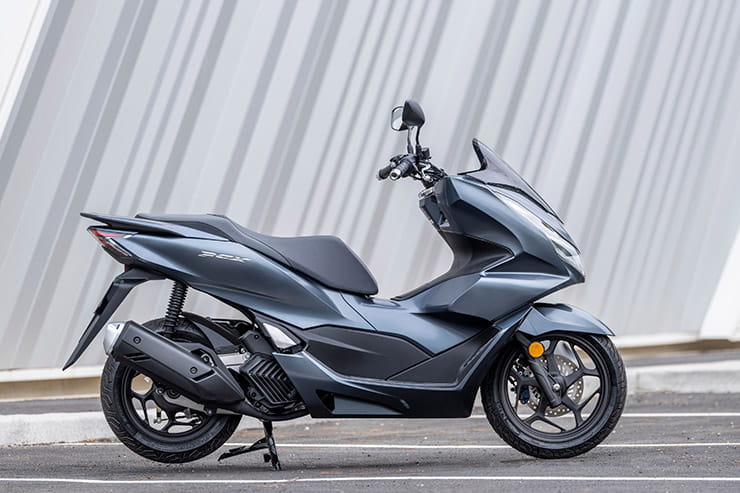
Honda’s PCX 125 has been the best-selling bike in Britain for a number of years but, faced with ever stiffer competition from the likes of Yamaha’s NMAX and low-cost Chinese imports, has been updated for 2021. At first glance, the new bike doesn’t look much different, but we all know looks can be deceiving, so we compared it directly to the outgoing 2020 model to see how much of an update it really has received.
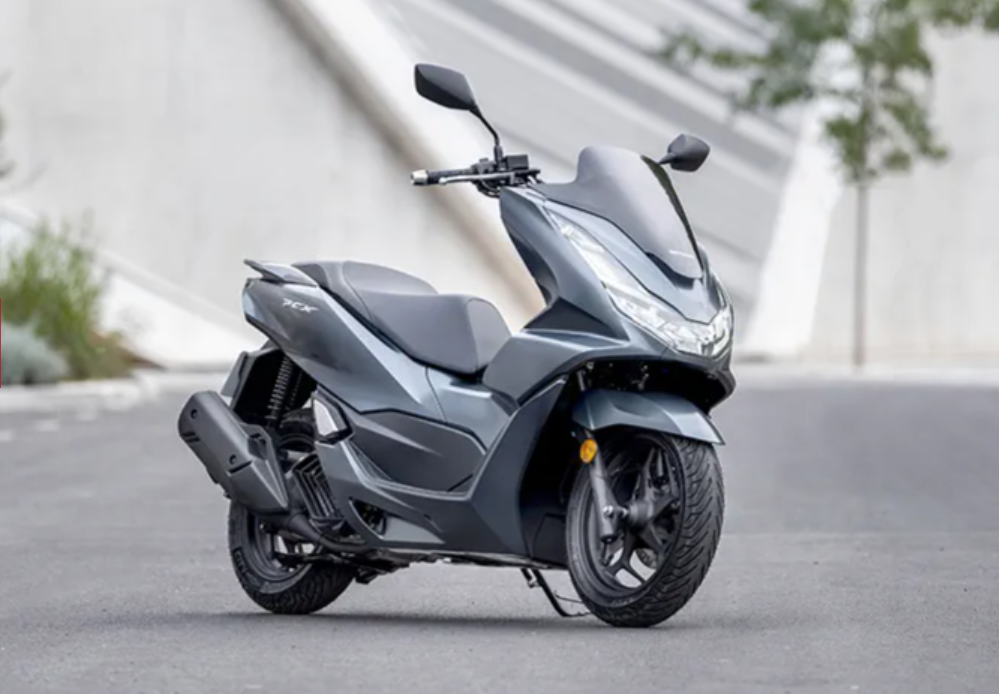
Power and torque
Power is up fractionally for 2021 with the revised ESP+ engine making an extra 0.2kW(0.268bhp) over the previous generation ESP engine, but the key difference is that it’s made higher in the rev range at 8750rpm compared to 8500rpm for the previous model. Is this extra power noticeable on the road though?
Around town the improved pick up off the line is better and torque figures make it better through the rev range.
I suspect that the majority of the difference in performance it not down to the engine changes alone as, as with any CVT system, performance characteristics can be altered by changing roller weights (lighter rollers allow the engine to spin up higher before engaging) allowing the bike to make the most of any altered engine characteristics. (A quick check of Honda part numbers does indeed confirm that the rollers have different part numbers between the years).
Engine, gearbox and exhaust
For 2021, the PCX is equipped with Honda’s next generation eSP+ engine – a fully Euro5 compliant unit which achieves the higher emissions legislation by adopting a four-valve head in place of the previous engine’s two-valve configuration. The engine bore and stroke have also been changed, enlarging the bore (improving fuel efficiency and torque), while reducing the stroke (allowing the engine to rev higher). Air intake and exhaust have also been optimised for air flow and efficiency.
On the road, the differences between the two bike’s engines were very subtle, but noticeable. Jumping from one bike to the other, there was a definite improvement in drive – not night and day, but enough to be noticeable with the 2021 bike feeling less stressed when maintaining high speeds and pulling away from the lights a little quicker.
We both noticed a difference in exhaust note, which, to be honest, made the 2021 model sound a bit ‘tinny’. The new bike carries a completely redesigned exhaust with a much slimmer profile, but after a few hours on the road, we both preferred the sound of Gavin’s 2019 model.
2021 Honda PCX125 Economy
Economy has always been a selling point for scooters of all sizes, with figures in excess of 100mpg the norm in this class, and the 2021 PCX125 continues this with a claimed average consumption figure of 134.5mpg without use of the Stop/Start feature.
While a series of heavy-handed test rides is never an ideal way to test everyday fuel consumption, we managed similar figures of around 105mpg on the 2021 model. Even with fuel prices at a long-term high and a full tank costing around £10, the Honda makes sound financial sense for low-cost commuting.
One update we did notice in the petrol station is the addition of a small holder on the underside of the fuel filler flap, which allows the quick and easy stowage of the fuel cap – a nice touch and one that I am sure will be welcomed by owners.
Handling, suspension, chassis and weight
While the forks have been carried over from the outgoing model to the new 2021 bike, the rear suspension has received an overhaul with longer stroke shocks, taking the rear travel from 84mm to 95mm, despite keeping the seat height the same at 764mm.
The chassis has also received a slight tweak from the previous model with the trail being tightened to 80mm from 86mm, quickening the steering slightly.
On the road, these slight changes were surprisingly evident with the new bike feeling both quicker to steer without being flighty, and smoother on Peterborough’s less-than-billiard table-like roads.
“The new bike felt much more agile in the turns, but more stable on faster roads and around roundabouts. It’s really confidence inspiring.” was Gavin’s first reaction, and I agree – the new bike is a step change up from the old one.
Handling is further helped by the new wheels which, while staying at 14″ diameter up front, change to 13″ at the rear and gain some width, now being fitted with Michelin City Grip 110/70 tyres up front and 130/70s on the back (previously 100/80 and 120/70).
2021 Honda PCX125 Brakes
Perhaps the biggest area where the PCX is starting to a bit long in the tooth, and yet surprisingly hasn’t been updated, is in the braking department.
While competitors such as the Yamaha NMAX have discs all round, Honda has continued to fit the PCX with a rear drum. While this works adequately given the speed and weight of the bike, it does mean that there’s also no ABS at the back meaning that grabbing a handful of rear will result in a locked wheel and associated squealing. Once the infantile enjoyment of skidding up to every set of lights has waned (it took a while for me), it also means that periodic adjustment of the rear brake is necessary to maintain optimum braking force.
Don’t get me wrong, both the outgoing and incoming models of PCX have more than enough braking to safely stop in a variety of conditions, especially with the excellent linked front brake system, but to keep up with the Joneses, I would think this will be the next area of improvement when the model received its next update.
Comfort over distance and touring
The old adage of ‘if it isn’t broken, don’t fix it’ certainly holds true with the PCX and, as you would expect for such an update, the overall riding position, comfort and riding experience is pretty similar between both bikes. This is a good thing if you get on with the current bike (it seems to be one-size-fits-all already with quite a difference between me and Gavin, but with both of us finding the bike comfortable), but bad news if you find the PCX a little cramped around the legs (particularly tall riders).
The updated screen, despite only a minor change, actually provides a significant improvement in the reduction of airflow to the rider, particularly around the hands – which will be welcome by all.
While our test ride wasn’t exactly a full day in the saddle, right from the off, the riding position is comfortable and relaxed with enough room, both on the seat, and around the footboards, to allow a good range of positions to avoid fatigue.
Rider aids and extra equipment / accessories
The rider aids are where Honda has more obviously splashed the cash with the new model with the addition of keyless ignition, switchable traction7 control, updated LED lights, USB charging points and a larger storage cubby under the seat. Honda has obviously been listening to their customer base and tried to accommodate the finer points that city riders, and more importantly, delivery riders want from the bike.
The underseat cubby is a massive improvement over the outgoing bike, with the reduction of the stepped floor of the old model meaning much more usable space. You may need to still choose your helmet carefully though as, while my chinless Jet helmet fitted well, a more bulky and vented full face helmet might struggle.
2021 Honda PCX125 verdict
The PCX is still a great bike, made even better in its 2021 guise. Should you go out and trade up your 2019 models? Well, yes and no. If you are coming to the end of your PCP deal, it may be worth considering the new bike. It will feel fresh and new while still feeling familiar, but it’s probably not worth cashing early for the upgrade – the difference between the two bikes is just too small.
For those new to scooters, the PCX still provides an affordable, economic, stylish entry point which makes urban commuting a breeze while still being able to cope with the odd out of town excursion.
With the ever-tightening gap in spec and price between the PCX and the NMAX, it’s going to come down to personal preference on styling, colour choices and, perhaps more importantly, dealer support that you have in your area.
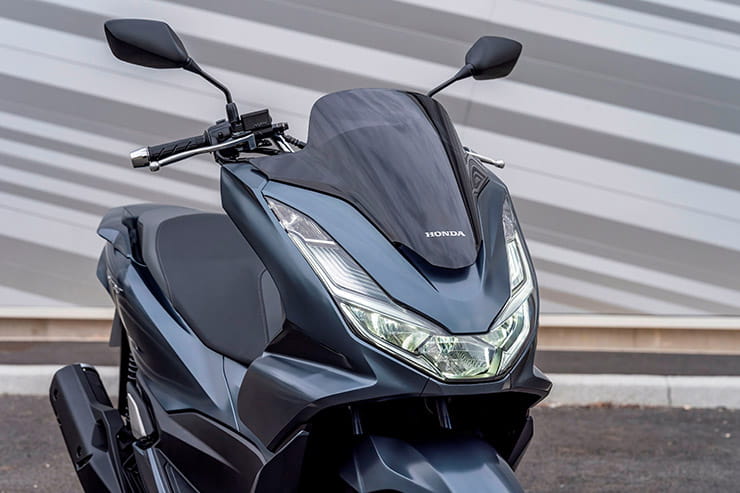

10 New Motorcycles To Look Forward To In 2023
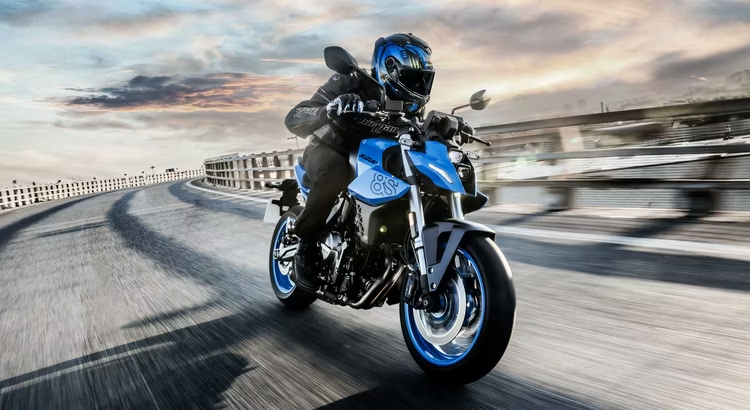
At first glance, 2023 might not look as if it’s going to be a vintage year for brand-new models from the world’s motorcycle manufacturers. Many existing models are halfway through their life span, and as such, aren’t due for replacement for another couple of years, at least. But, that doesn’t mean that there isn’t plenty to look forward to and the recent EICMA motorcycle show in Milan, Italy, gave us a taste of what we can anticipate in 2023.
1 Honda Transalp
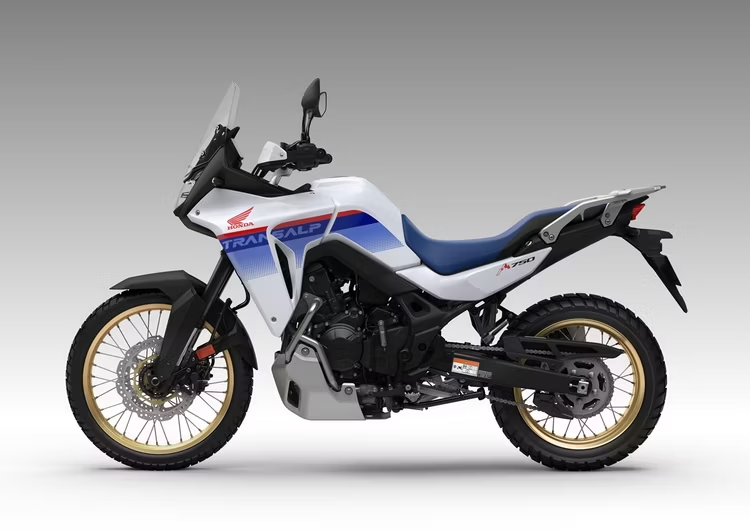
Honda made a big splash with the 1100cc Africa Twin but, up to now, there was a big gap between that and the CB500X, which, in reality, is more road-biased with a modicum of off-road ability. For 2023, Honda is resurrecting a famous name from the past, the Transalp, to plug that gap. The original Transalp was produced from 1987 through to the late 2000s and was powered by a V-Twin, liquid-cooled engine of between 583 and 755cc. The new Transalp will be powered by a 755cc parallel twin, developing 91 horsepower and 55 pound-feet of torque, and Honda has worked hard to strike the right balance between urban agility, long-distance, on-road touring comfort, and off-road ability. A 21-inch front wheel declares its off-road pretensions and the new Transalp will play in an increasingly congested market, with models from Suzuki, Yamaha, Aprilia, BMW, KTM, and Triumph. As is normal, the electronics package is comprehensive, with ride-by-wire throttle, preset power modes, adjustable traction control, ABS, and engine braking. A Showa suspension (non-adjustable) is fitted and there’s 8.3 inches of ground clearance. The seat height is 33.5 inches.
2 Suzuki GSX-8S

Parallel twin engines are all the rage at the moment, and Suzuki has seen fit to jump on the bandwagon with such an engine, replacing not only the venerable V-Twin that has seen service in the SV650 and V-Strom 650 but also the 750cc inline-four that was used on the GSX-S750 naked roadster. The SV650 will continue for a while yet but expect it to be phased out. We’ll get to the new V-Strom 800 in a moment but just as noteworthy is the new GSX-8S, a middleweight naked roadster companion to the GSX-S1000S. The 776cc parallel-twin engine is brand new and features 270° firing order to give it the characteristics of a V-twin, but in a more compact package that will also be cheaper to manufacture and maintain. The steel trellis frame and swing arm are also completely new. It promises to be an affordable entry into the middleweight sporting naked bike class, with non-adjustable KYB suspension, Nissin brakes and non-IMU ABS and traction control. Suzuki has an enviable reputation for solid engineering and there is no reason to doubt that the GSX-8S will be any different.
3 Triumph Street Triple 765 R, RS, and Moto2

Long acknowledged as one of the best chassis in motorcycling today, Triumph’s junior naked sports bike just keeps getting better and better. 118 (‘R’) or 128 (‘RS’ and Moto2) horsepower, 59 pound-feet of torque, and a screaming 12,000rpm redline, with a broad spread of power from the inline triple-cylinder engine. Shortened gear ratios give stunning acceleration and the bi-directional quick-shifter allows you to wring every last ounce of performance out of it. Matches the Speed Triple 1200RS in the electronics department and the chassis and suspension geometry gives super-sharp handling. Three versions are available: ‘R’, ‘RS’, and range-topping Moto2 Edition, which boasts top-shelf Öhlins suspension and a much racier riding position thanks to the clip-on handlebars. Styling getting more angular every year but it’s still good-looking.
4 Ducati Scrambler 800

Not a new model but updated sufficiently to warrant inclusion here. The original Scrambler appeared in the 1960s and the concept was re-imagined for 2015, with a V-Twin engine in place of the original’s single-cylinder unit. It quickly became Ducati’s best-selling model, propelling the company into the top ten in the European sales charts for the first time. Outwardly, the 2023 Scrambler looks the same but a lot has changed. There’s a new and nine-pound-lighter trellis frame, swing arm, and subframe. The engine is still the Desmodue, 73-horsepower, air-cooled V-Twin. Ride-by-wire throttle allows traction control and both TC and ABS are lean-sensitive. Three models are available: Icon, Full Throttle, and Nightshift, which are essentially just cosmetic differences.
5 Suzuki V-Strom 800DE
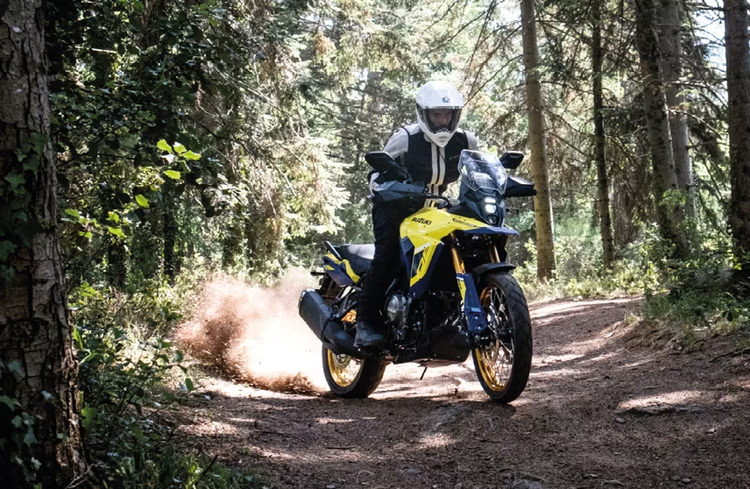
Suzuki has always had a much lower profile for its adventure bikes than the likes of KTM and BMW which is a pity as, in terms of real-world ability, the Suzuki V-Strom, in either 650cc or 1000cc guise, has always been a decent adventure bike, if lacking in the extreme electronic sophistication of its rivals. For 2023, Suzuki is sadly moving away from the brilliant little 650c V-Twin engine as found in the V-Strom 650 and SV650. In its place is coming the new 776cc parallel twin as described above for the Suzuki GSX-8S. The V-Strom 800DE is a new bike from the ground up, with a steel backbone frame and detachable subframe, which is essential to curb crash damage costs. With the new model, Suzuki is taking direct aim at the Yamaha Ténéré 700, which is a tall order but, on paper at least, it looks as if Suzuki has it covered. Fully adjustable Showa suspension has 8.7 inches of travel, giving the same amount of ground clearance. Weight is 507 pounds with all fluids and a full tank of gas. Wheel sizes are 21-inch front and 17-inch rear, ABS and traction control are multi-faceted and can both be turned off (rear only for the ABS). A quick shifter and Suzuki’s anti-stall mechanism round off the electronics, all of which are controlled via a full-color TFT dash.
6 Triumph Chrome Editions

Okay, not new models per se but still worthy of inclusion in this list. There was a time when chrome was an important element of gas tank design, especially for British motorcycle manufacturers. Beautifully pinstriped in gold, silver, blue or black, the chrome brought a welcome touch of glitter to drab pre-war color schemes. With improvements in paint technology, chrome disappeared from gas tanks from the 1970s onwards. Still, Triumph has decided to invoke the glory days of the British motorcycle industry with a range of chrome tanks fitted to its modern classic range of Bonnevilles and derivatives and also the Rocket 3. To say they look spectacular would be an understatement. Available for one year only.
7 BMW M1000RR

BMW’s flagship superbike, the M1000RR, gets a raft of updates for 2023, as if you could make the bike any more insane than it already is! Bodywork has new aerodynamic winglets producing even more downforce, even when leaned over in a corner, without an increase in drag. Aerodynamics now extend to the front wheel and fender, directing cooling air onto the brake calipers. Dripping in carbon fiber, this is as thinly disguised a race bike as you could possibly want. BMW’s sights are firmly set on World Superbike racing success, which was the reason for the original S1000RR’s existence in the first place. 205 horsepower, 189mph, and up to $40,000 if you tick all the option boxes. Extreme, but brilliant. Also available is the naked M1000R, which is exactly the same as the RR in terms of specification.
8 Honda Hornet CB750

Honda is re-establishing itself as a manufacturer of practical, beautifully built but perhaps slightly staid motorcycles. In its own words, “Honda’s design philosophy is to create something pure and functional in an uncomplicated way—models which are both beautifully simple and emotionally appealing.” The parallel-twin engine is the new buzzword in motorcycling and Honda is no different from any other manufacturer. The new Hornet revives a much-loved name from Honda’s past, this time with a 91 horsepower, 55 pound-feet parallel twin engine, with a 270° crankshaft to give the feel of a V-Twin. The top speed is a claimed 127mph. Small, light, and compact with a reasonable seat height, the Hornet CB750 will be a perfect stepping stone from beginner to experienced. Extensive but sensible electronics package with the now-ubiquitous TFT dash. The Hornet joins a long list of middleweight naked sporty bikes from Japanese manufacturers so will have its work cut out to make an impact.
9 Royal Enfield Super Meteor 650
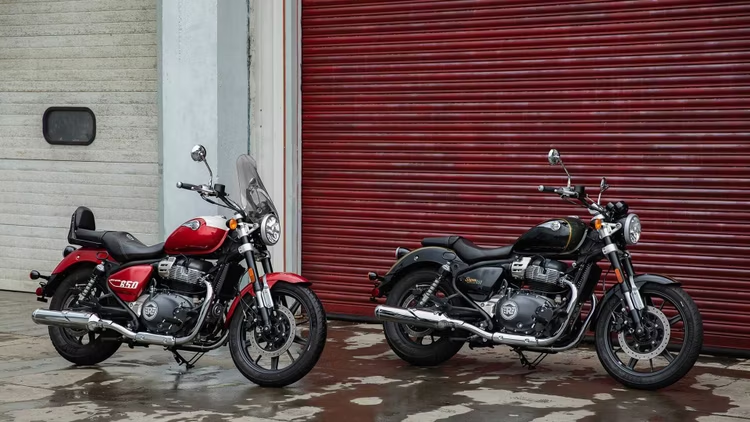
Royal Enfield is really stepping up its bid for worldwide sales success with its range of parallel twin-engined Meteor models, first seen in 2018. For 2023, the company has added the Super Meteor ‘cruiser’ and touring models, undoubtedly aimed squarely at the American market. 47 horsepower and 39 pound-feet of torque and a curb weight of 531 pounds will make for leisurely performance, but the engine has proven itself to be smooth and reliable, while the chassis, designed by specialists Harris in the UK, means it will have excellent road manners should you want to push on a bit away from the highways. No U.S. prices have been announced but expect it to be among the cheapest cruisers on the market without sacrificing quality.
10 Norton V4SV

Something super-exotic to finish off with. After the recent financial problems, Norton seems to be on a more secure path after Indian concern TVS took control. The V4SV started life under the old regime but will finally appear for good in 2023. It won’t be cheap – at GBP 44,000 it is £10,000 more expensive than the Ducati Panigale V4 SP2, but what price exclusivity? The Norton-built V4 engine pushes out 185 horsepower and 92 pound-feet of torque. It is housed in an aluminum-tube perimeter frame and chock-full of high-end components from the likes of Öhlins, Brembo, and BST carbon or OZ forged wheels. Fast, utterly beautiful, exclusive, and the start of something great for the revitalized Norton brand. Long may it continue.
